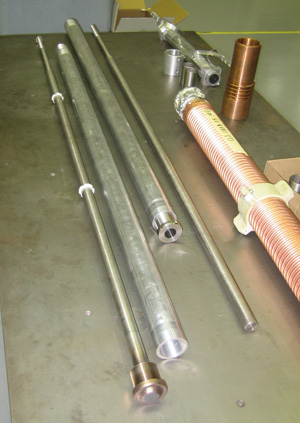LHC Triplet Repairs Underway at CERN
 |
| Pieces for the assembly of cartridges for triplet repair have begun to arrive at CERN, including aluminum outer tubes and Invar rods that fit into the tubes. At right is one of the new heat exchangers installed in the triplet magnets. (Image courtesy of Peter Limon.)
|
Scientists, engineers and technicians from CERN, Fermilab, Lawrence Berkeley National Laboratory and Japan's KEK laboratory have begun repairs to the "triplet" components of the Large Hadron Collider that failed a pressure test in the LHC tunnel in March.
Following a mechanical review at CERN of the triplets and the proposed fixes on April 24 and 25, Fermilab also conducted a review of the magnet fixes on May 16-17, and of the repairs to the cryogenic and power distribution boxes, or DFBXs, on May 24. All reviews concurred with the design choices for triplet repairs and recommended areas for further investigation and testing to forestall any potential problems.
As described in the May 11 Update, a set of four metal cartridges will be installed in each of 18 quadrupole magnet assemblies to reinforce the internal support structures that broke in one such magnet during the pressure test.
Materials for the cartridges have arrived at CERN, where tests of individual cartridge components and joints are underway. Following assembly and testing of the cartridges, they will be installed in a triplet quadrupole magnet currently in a surface building at the laboratory. Engineers will use a hydraulic device to simulate the asymmetric forces applied to the magnet during a pressure test. After the hydraulic test has shown that the cartridges in fact keep the magnet from moving, as they are designed to do, cartridges will be installed in the remaining triplet magnets. Most of the installation work will be done without removing the magnets from the LHC tunnel.
The March pressure test also revealed minor design problems in the triplets' DFBX's, for which fixes have been designed, reviewed, and agreed on. Parts are being made and tested, and plans call for repairs to begin in mid-June.
Analysis of the pressure-test forces has also shown that stands for the triplets could fail under certain conditions. Engineers have designed modifications to the attachment to the tunnel floor and will test them at the same time as the cartridge test.
At Fermilab, a review of the root causes of the triplet failure began on May 29. Fermilab expects the review, which is being conducted by EG&G, a management consultant under contract to Fermilab, to produce a report in about eight weeks.
LHC Magnet Update Archive
|